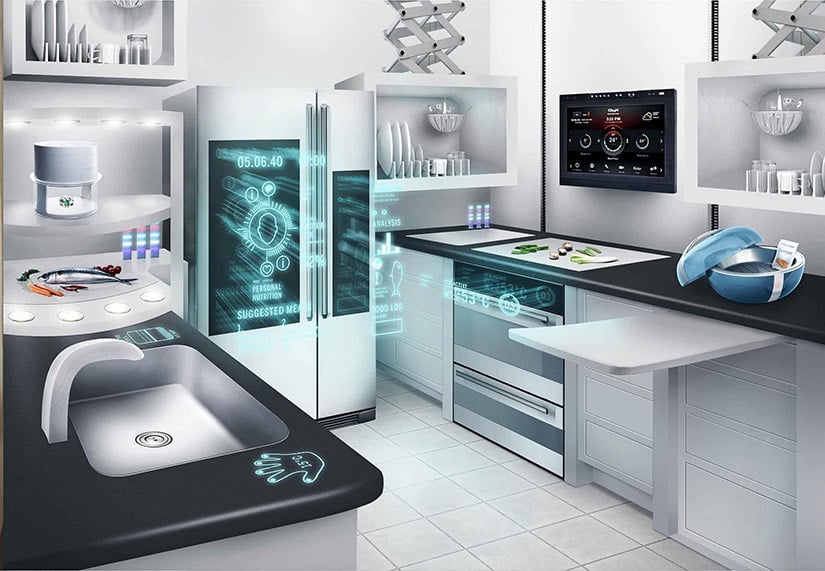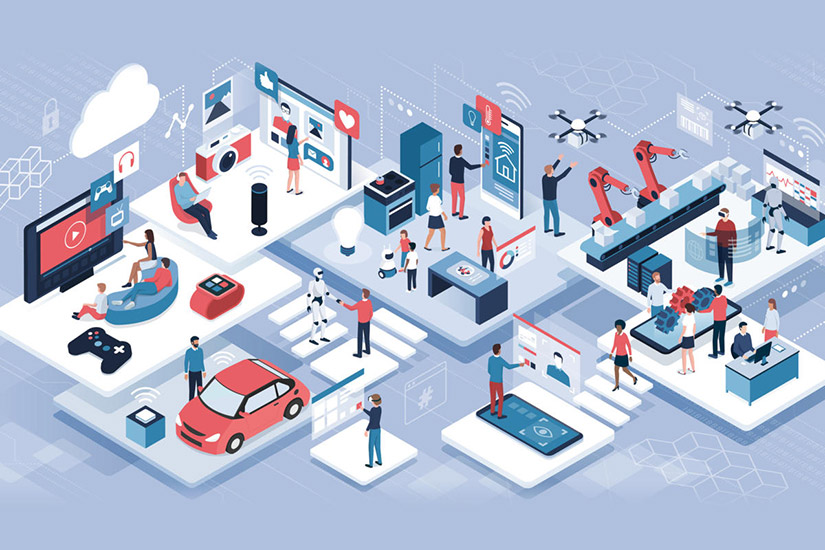kitchen remodeling
What the Internet of Things Will Mean for Your Smart Kitchen in 2025

The kitchens of the future will be very different than the ones we currently enjoy. However, what do we mean by “the future?” Actually, it’s closer than you may imagine. What we’re talking about is how a smart kitchen will look in 2025. That year is shaping up to be an exciting one for technology and connectivity, and it all starts with the Internet of Things.
What is the Internet of Things?

To understand the Internet of Things (IoT), we need to talk about your cell phone. Chances are, you have 4G service. The “G” in 4G stands for “generation.” Sidenote: this is different from the “G” in 2.4G or 5G Wi-Fi, which stands for GHz or gigahertz.
So your phone is on the 4th generation cellular network. Did you know that 5G is also coming out right now? Some cities have it, but most places don’t. The speeds available now are also nowhere near what the full network will offer in just a few years.
Telecom companies estimate that 2025 will be the year when 5G is fully available and at the promised speeds. And those speeds are fast. For example, you’ll be able to download a three-hour movie on your phone in about three seconds?instead of ten minutes.
What’s that got to do with your kitchen? Well, the 5G network isn’t just an upgraded 4G system, and it’s not just going to affect phones. It’s a fundamental evolution. It provides a huge boost in three areas: speed, latency, and bandwidth.
The 5G network will be 100 times faster than 4G. That’s huge. It will also have near-perfect latency, which means smart cars can react to obstacles faster than their drivers. Humans have a reaction time of about 250 ms, but cars on the 5G network will have a 3 ms reaction time.
Lastly, there’s a lot more bandwidth. Think of bandwidth as the width of a faucet. The wider the faucet, the more water that can come through. Similarly, technologists expect over 10 billion devices to be connected to the 5G network by 2025. The 4G network can’t handle anything near that amount of connections.
A connected device doesn’t have to be a phone or computer. It could be a sensor in a car, doorbell, parking meter, street light, or a million more possibilities. All of these devices will connect and interact with each other without human intervention, and that’s what we call the Internet of Things.
Smart kitchens of today vs the future

So, back to your kitchen. Today, you can get a smart fridge, or smart oven, or smart toaster. Basically, these things are all separate. You can connect them on your Wi-Fi network, but you have to control them. Many of these things offer voice control capabilities or simple ways to set up routines. You can preheat your oven from an app on your phone, or view what’s in your fridge remotely.
That’s all pretty neat, but there’s a common element here. These systems all need your direct input. True, there are some things that can be automated, but you still have to set schedules manually. In contrast, the smart kitchen of 2025 will learn your routines from other sensors in your house. It will be more like having an assistant in your home.
For example, you could set a time that you like to have your coffee made every morning. You can do that today with any decent coffee maker. However, what if you sleep through your alarm? Or what if you wake up an hour before? Sensors in your bedroom could signal to your coffee machine exactly when to brew the coffee based on when you really wake up.
Sure, you can get a refrigerator today that will let you know when you’re running low on food. It can do that via sensors in the device. However, kitchens of 2025 and beyond will be much more advanced than that. How about a refrigerator that tells you what kind of nutritional value is in the food inside?
Imagine a stovetop that can sense exactly what is placed on it. Sensors inside coffee mugs, baby bottles, tea kettles, sauce pots, and more would communicate via the new network with your stovetop. You could put a coffee mug down and it would know to warm it to your favorite temperature.
Since it’s the morning, perhaps it’s also time to get a bottle ready for the baby. You could set it on the same surface and the stove would gently warm the bottle to the right temperature for your baby.
It’s about automation

Simple tasks like boiling water could be completely automated. All you would have to do is leave a pot on the stove. Twenty minutes before dinner time, a faucet over the stove could fill your pot, the stove could turn on, and it could send you a text when the water is ready for the pasta.
Perhaps you want to wait until everyone is home to begin the process. No problem. You could tell your home network to not start the water until it senses that each family member’s smartphone is on the premises.
The main thing that makes the smart kitchen of 2025 different from today is connectivity on the Internet of Things. In one kitchen, you could have a hundred different sensors that interact and communicate with one another.
Imagine a dishwasher that could warn you if you place a dish that’s unsafe for the washer inside. Or a microwave that could do the same for different materials. Or a home device that can give you recipe ideas based on what you have in your fridge and pantry without you even having to look.
Of course, this wouldn’t take the joy of cooking away at all. It will just make things easier. For example, when was the last time you thought you had all the ingredients for a recipe on your way home only to find out you really didn’t?
In the future, your kitchen will know what you have on hand. On your way home from work, you could open your home kitchen app and double-check exactly what you have in your pantry. That means no more settling for another dish or pushing off dinner for an hour while you go out to restock.
What’s so cool about all this is that it’s not very far off. The 5G network is rolling out right now, and manufacturers are designing products to use its capabilities. New technology will continue to influence what’s trending in the kitchen. In the future, it will be less about smart devices and more about helpful networks that connect the things you use in your daily life.
![See your dream kitchen in 3D [GET YOUR FREE DESIGN]](https://cdn.kitchencabinetkings.com/blog/wp-content/uploads/see-your-dream-kitchen-in-3d.webp)
![Contractor Discount Program: Offering contractors and builders special volume discounts on all applicable orders [LEARN MORE]](https://cdn.kitchencabinetkings.com/blog/wp-content/uploads/contractor-discount-program.webp)
![Explore our photo gallery [GET INSPIRED]](https://cdn.kitchencabinetkings.com/blog/wp-content/uploads/explore-our-photo-gallery.webp)
![What everyone is saying about KCK [READ REVIEWS]](https://cdn.kitchencabinetkings.com/blog/wp-content/uploads/what-everyone-is-saying-about-kck.webp)
![Get a cabinet sample [SHOP SAMPLES]](https://cdn.kitchencabinetkings.com/blog/wp-content/uploads/get-a-cabinet-sample.webp)
![Pay over time, on your terms with Affirm [LEARN MORE]](https://cdn.kitchencabinetkings.com/blog/wp-content/uploads/pay-over-time-on-your-terms-with-affirm.webp)
Hi, thanks for such an informative post. I think IOT has many benefits as you said. In kitchen, IOT makes things easier and faster. You will always be entertained using it. Modernizing your kitchen always gives fresh feeling.